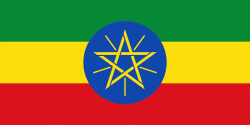Soddu Airport (Soddu Airport)
Sodo Airport is an airport serving in Wolaita Sodo, a city in Wolaita Zone, Ethiopia. The airport is located 10 km (6 miles) to northern part of the city. Currently, the airport is not under operation and its reconstruction is started in 2022.
In 20 November 1974: An Ethiopian Airlines Douglas C-47A, registration ET-AAR, that was due to fly a domestic passenger service to Beica, crashed on take-off. There were 24 occupants on board; both the pilot and the co-pilot perished in the accident. In 15 October 1978: Due to the loss of hydraulic pressure, an Ethiopian Airlines Douglas C-47B, registration ET-AGK, was diverted to the airport. The engines were cut out following landing, and the aircraft ended up in a drainage ditch. There were no fatalities, but the aircraft was written off.
In 20 November 1974: An Ethiopian Airlines Douglas C-47A, registration ET-AAR, that was due to fly a domestic passenger service to Beica, crashed on take-off. There were 24 occupants on board; both the pilot and the co-pilot perished in the accident. In 15 October 1978: Due to the loss of hydraulic pressure, an Ethiopian Airlines Douglas C-47B, registration ET-AGK, was diverted to the airport. The engines were cut out following landing, and the aircraft ended up in a drainage ditch. There were no fatalities, but the aircraft was written off.
Map - Soddu Airport (Soddu Airport)
Map
Country - Ethiopia
 |
 |
| Flag of Ethiopia | |
Anatomically modern humans emerged from modern-day Ethiopia and set out to the Near East and elsewhere in the Middle Paleolithic period. Southwestern Ethiopia has been proposed as a possible homeland of the Afroasiatic language family. In 980 BCE, the Kingdom of D'mt extended its realm over Eritrea and the northern region of Ethiopia, while the Kingdom of Aksum maintained a unified civilization in the region for 900 years. Christianity was embraced by the kingdom in 330, and Islam arrived by the first Hijra in 615. After the collapse of Aksum in 960, a variety of kingdoms, largely tribal confederations, existed in the land of Ethiopia. The Zagwe dynasty ruled the north-central parts until being overthrown by Yekuno Amlak in 1270, inaugurating the Ethiopian Empire and the Solomonic dynasty, claimed descent from the biblical Solomon and Queen of Sheba under their son Menelik I. By the 14th century, the empire grew in prestige through territorial expansion and fighting against adjacent territories; most notably, the Ethiopian–Adal War (1529–1543) contributed to fragmentation of the empire, which ultimately fell under a decentralization known as Zemene Mesafint in the mid-18th century. Emperor Tewodros II ended Zemene Mesafint at the beginning of his reign in 1855, marking the reunification and modernization of Ethiopia.
Currency / Language
| ISO | Currency | Symbol | Significant figures |
|---|---|---|---|
| ETB | Ethiopian birr | Br | 2 |
| ISO | Language |
|---|---|
| AM | Amharic language |
| EN | English language |
| OM | Oromo language |
| SO | Somali language |
| TI | Tigrinya language |















